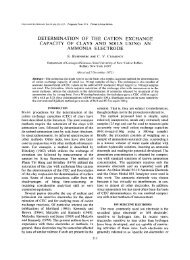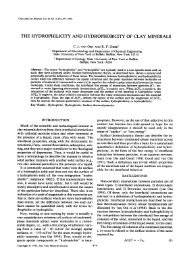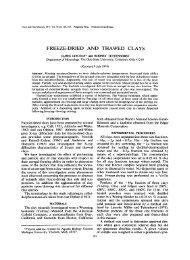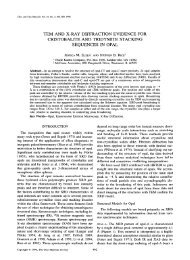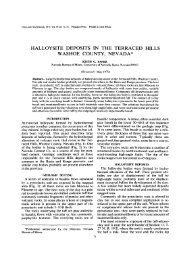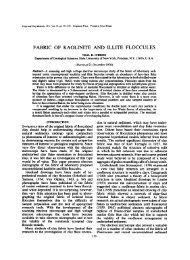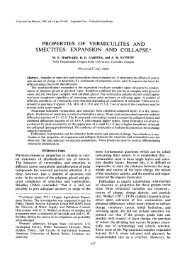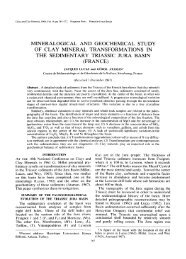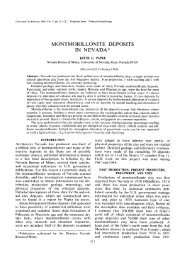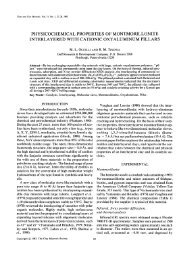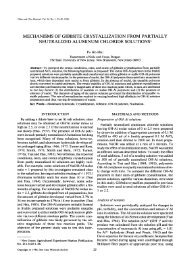formation of halloysite from feldspar: low temperature, artificial ...
formation of halloysite from feldspar: low temperature, artificial ...
formation of halloysite from feldspar: low temperature, artificial ...
Create successful ePaper yourself
Turn your PDF publications into a flip-book with our unique Google optimized e-Paper software.
. . . Har<br />
14 WALTER E. PARHAM<br />
Localities where <strong>halloysite</strong> has been identified as a<br />
modern weathering product are shown in Fig. 1,<br />
and the authors, geographic areas, and rock types<br />
studied are listed in Table 1. Table 2 is a tabulation<br />
<strong>of</strong> the various analytical techniques used to identify<br />
the clay minerals in each study. Only about 25<br />
et al. (1963) partially agree, but believe that<br />
<strong>halloysite</strong> may form at times without allophane<br />
as the intermediate material.<br />
It seems that there is considerable uncertainty<br />
in our understanding <strong>of</strong> the transition <strong>of</strong> mineral<br />
phases that take place when alumino-silicate<br />
.... ' .... ~ Grant,<br />
Bates, 1962 ~<br />
~./Patt 1e r 1s<br />
~176 9 6<br />
/M ~ Nakamura et al<br />
oberly 1963<br />
Uehara et al 1966<br />
Verguson,<br />
19<br />
196v~ {<br />
63OJ<br />
Simonette et al,<br />
1963 "" @<br />
\~lexander<br />
1943 I<br />
%~m, ant, 1964<br />
et al,<br />
~$; Beaven et al<br />
q ~ 1966<br />
Fairbairn et al 1966<br />
9 v Ostrowicki, 1965<br />
9 Lisitsyna, 1966<br />
t~h~l et al,<br />
%k<br />
~eutelspacher et al 1961 ~ ~ ~ \ 9 / . . . . .<br />
,, , , . - ) x) ~ -- I t3eute,spacher et al, 1961.-~ ~<br />
",', "-4 2' .<br />
\<br />
onct al,<br />
Sudo ct al, 1956<br />
Hosking<br />
1957<br />
Birrell et al, 1955<br />
Fig. 1. Localities <strong>of</strong> studies <strong>of</strong> recent weathering in which <strong>halloysite</strong> has been identified.<br />
per cent <strong>of</strong> these studies listed kaolinite as being<br />
present in the weathering products. Grim (1968)<br />
has commented that "Although the presence <strong>of</strong><br />
<strong>halloysite</strong> in weathering products is well established,<br />
it is a rare component <strong>of</strong> such materials,<br />
and peculiar conditions must be required for its<br />
<strong>formation</strong>."<br />
His view was understandable, as 50 per cent <strong>of</strong><br />
those studies listed in Table 1 are not more than 4<br />
yr old. Keller (1964) noted that "... alumlnous<br />
silicates react with water to give rise.., to .... a<br />
clay mineral."... "Field occurrences show that<br />
the clay mineral formed is commonly either allophane<br />
or <strong>halloysite</strong>..." He further noted that "In<br />
our present stage <strong>of</strong> knowledge, it may be stated<br />
that K-<strong>feldspar</strong> alters to kaolinite via intermediary<br />
mica under certain conditions, but directly to<br />
kaolinite under others, and that it alters to <strong>halloysite</strong><br />
(endellite) via a gel phase, possibly including<br />
transitory allophane." Sudo and Takahashi (1956)<br />
suggested, and Jackson (1959) seems to agree, that<br />
there may be a gradual transition in the products <strong>of</strong><br />
chemical rock weathering <strong>from</strong> allophane to<br />
<strong>halloysite</strong> 9 4HzO to <strong>halloysite</strong>. 2H._,O. Chukrov,<br />
minerals decompose during chemical weathering<br />
to form new products, particularly tubular <strong>halloysite</strong><br />
and platy kaolinite, and that the electron microscope<br />
may be a valuable tool when used to study<br />
the beginnings <strong>of</strong> decomposition <strong>of</strong> one mineral,<br />
i.e. <strong>feldspar</strong>, and the <strong>formation</strong> <strong>of</strong> its alteration<br />
products. Therefore, a study was begun to determine<br />
what surface alteration products form<br />
during natural weathering <strong>of</strong> <strong>feldspar</strong> in the humid<br />
tropics as well as what products form on <strong>feldspar</strong><br />
surfaces under similar conditions in artifical<br />
weathering.<br />
PROCEDURE<br />
The products forming on <strong>feldspar</strong>s in igneous<br />
rocks <strong>from</strong> Hong Kong were selected for the study<br />
<strong>of</strong> natural weathering (Fable 4). Hong Kong, which<br />
adjoins the southernmost point <strong>of</strong> Kwantung<br />
Province, China, lies just within the northern limits<br />
<strong>of</strong> the tropics, has hot humid summers and somewhat<br />
cooler and drier winters, and an average<br />
annual rainfall <strong>of</strong> 85 in. Altitudes ranging <strong>from</strong> sea<br />
level to about 3000ft within the Colony afford<br />
conditions <strong>of</strong> good drainage over much <strong>of</strong> the area.



